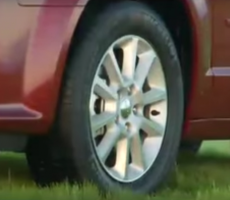— A Chrysler minivan valve stem lawsuit won't include a Dodge Grand Caravan owner who joined an existing class action filed over the tire pressure monitoring systems.
Plaintiff Robert Tomassini filed the valve stem class action lawsuit alleging the stems are defective in 2008-2011 Dodge Grand Caravan and Chrysler Town & Country minivans.
The plaintiff eventually filed a motion to permit Mr. Thomas Hromowyk to be added as an additional class representative, and the judge agreed and allowed the plaintiffs to file an amended lawsuit.
Hromowyk says he purchased a new 2010 Dodge Grand Caravan in October 2009. In February 2013, the plaintiff says he took the minivan to a third-party repair shop and had all four tires replaced.
Hromowyk did not watch any part of the service and the condition of the vehicle's tire pressure monitoring system (TPMS) is unknown because the repair shop threw out all the parts.
Hromowyk says in 2015 he noticed a low tire pressure warning, stopped to put air into the tires and noticed that the nut on the front left TPMS valve stem was gone. He took the minivan back to the repair shop and had the TPMS valve repaired.
Plaintiff Hromowyk alleges that in August 2015 his tire rapidly deflated and he noticed the TPMS valve was missing. Hromowyk took the vehicle to the same repair shop and had the front left TPMS unit replaced.
Two years later the front right TPMS unit was replaced, and the plaintiff says he requested the removed parts be returned to him. However, there is no record of that request.
In May 2018, Hromowyk took the vehicle to the repair shop to replace the left rear TPMS unit after he noticed the valve stem nut had cracked. And in April 2019, Hromowyk had the right rear TPMS unit replaced after he noticed the valve stem nut had cracked.
Chrysler filed a motion for "sanctions for spoliation," with spoliation described as, "the destruction or significant alteration of evidence, or the failure to preserve property for another's use as evidence in pending or reasonably foreseeable litigation."
According to the judge, there is no dispute that Hromowyk was in control of the evidence as it was attached to the vehicle which he owned. Based on court documents, Hromowyk clearly told a mechanic to remove the TPMS units, once prior to and twice after filing his lawsuit.
Hromowyk claims that when he directed a mechanic to remove the first TPMS unit, he wasn't aware of any lawsuits related to corrosion of TPMS valve stems or nuts.
Despite this, Hromowyk asked for the allegedly defective part to be returned to him, but when asked why he requested the TPMS unit be returned to him, Hromowyk testified he was told by lawyers to save the parts.
"Therefore, although Plaintiff Hromowyk had not yet filed his complaint, there was reason to believe that the TPMS unit would be relevant to future litigation. Thus, Plaintiff Hromowyk was under a duty to preserve evidence when he removed the TPMS unit on February 17, 2017." - Judge Mae A. D'Agostino
On March 10, 2017, 28 days after the first TPMS unit was removed, Hromowyk filed his lawsuit against FCA and eventually told a mechanic to remove two TPMS units from his vehicle on May 24, 2018, and April 11, 2019.
The owner of the mechanic's shop testified it can take significant force to remove the TPMS unit if the nut is falling apart or corroded. The force required would likely create additional stress on the part and "could result in the creation or exacerbation of cracking of the part."
The judge says a photo supplied by the plaintiff proves this because one of the units broke into multiple pieces.
According to the judge, there is no way to know if any possible cracks were caused by the strong force required to remove the TPMS units from the minivan.
The judge also found the plaintiff's actions show he acted with purpose to have the units and valve stems removed and replaced even though those components are at the very heart of the lawsuit.
Chrysler says this proves what the plaintiff did was intentional, and the judge agreed.
"Specifically, because of the significant alterations made to the TPMS units, Defendant is unable to inspect the TPMS units to determine whether the alleged defect existed prior to their removal from the vehicle. As Plaintiff Hromowyk testified, his claim is about whether the TPMS valve nuts suffered from stress corrosion cracking due to the part's inferior composition."
The judge references a separate lawsuit called, Mooradin v. FCA US, LLC where the plaintiff alleged Chrysler's manufacturing process caused sand to seep into the radiators.
The plaintiff agreed to produce the vehicle for inspection, but before the vehicle was produced, the plaintiff was told by his attorney to take the vehicle to a mechanic and have the radiator flushed. This removed the very radiator fluid at issue in the lawsuit. Additionally, the plaintiff took the vehicle to be serviced without providing notice to Chrysler.
In Mooradin, the court granted Chrysler's motion for sanctions for spoliation and disqualified the plaintiff from serving as a class representative.
According to the judge in the valve stem lawsuit, a similar outcome is appropriate and Hromowyk will not be allowed to represent minivan owners and lessees.
The Chrysler valve stem lawsuit was filed in the U.S. District Court Northern District of New York - Tomassini v. Chrysler Group LLC.
The plaintiff is represented by the Law Offices of Elmer Robert Keach III, P.C., Whitfield Bryson & Mason LLP, Parker Waichman LLP, Migliaccio & Rathod LLP, and Kantrowitz Goldhamer & Graifman, P.C.
CarComplaints.com has complaints about valve stem problems in the minivans:

